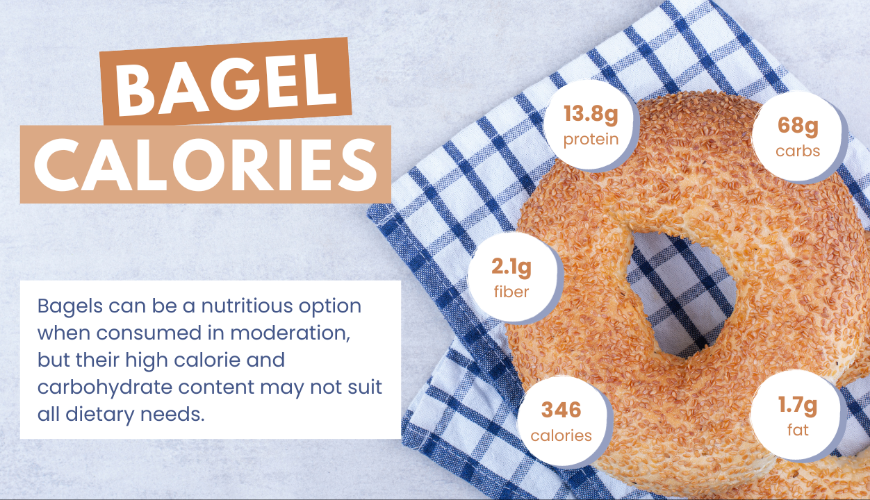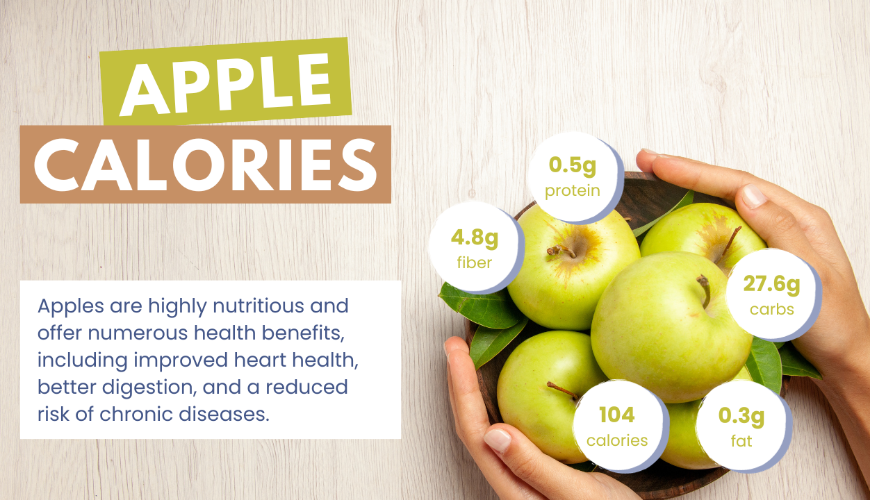Do you adore bagels and relish a warmed-up one in the morning or maybe a wholesome bagel sandwich for midday meals? Given their variety of tastes and types, these delectable rings of dough are handy and adaptable food items.
You may not realize this but the nutritional value of bagels has evolved over time due to changes in their manufacturing processes. If you’re aiming to keep track of your daily calorie intake or other vital nutrients, be sure to meticulously examine the nutritional details associated with your preferred bagel.
Dietary Information
This information regarding a bagel’s macronutrients is shared by the USDA for one large bagel, between 3 1/2 to 4″ across (131 g).
- Calories: 346
- Fat: 1.7 g
- Sodium: 553 mg
- Carbohydrates: 68 g
- Fiber: 2.1 g
- Sugars: 11 g
- Protein: 13.8 g
Most basic bagels are scarce in saturated fats and typically have no cholesterol or sugar content. These can be an excellent source of thiamin.
Bear in mind that your particular bagel’s calorie count and nutritional facts will fluctuate based on the specific brand you opt for. For instance, Lender’s Plain New York Style Bagels (freezer version) carry just 230 calories yet contain high fructose corn syrup. Consequently, every single piece carries a sugar load of about three grams.
The size of your chosen baked goods also factors into its calorie content; over time with bigger portions becoming mainstream during recent decades it has been noted that twenty years ago regular-sized ringed bread was merely three inches wide carrying around 140 calories (according to data provided by National Institutes of Health).
A typical bakery fresh plain variant could even measure up to six inches across equating to around 350 more calories towards your daily intake even if split with another person this still remains fairly calorific.
Nutritional profiles would vary further depending upon type as in cheddar pesto flavored bites from Bruegger’s Bagels offer users approximately 420 calories along with ten grams of fats and nine grams of sugars respectively.
Wellness Advantages
Often, unless they’re whole-grain based, bagels serve as a provider of refined carbs. The body’s main source of energy is carbohydrates. For individuals like athletes who require an instantaneous energy supply, refined carbs can be handy. But vitamins, minerals, and dietary fiber are lost when grains undergo the refining or milling process. In general terms, limiting your intake of refined grains is recommended by most nutritionists.
A label displaying “enriched” typically indicates that the food product has been processed or refined. Some nutrients get reinstated during manufacturing in these enriched items yet; such foods often lack fiber—an integral part of a wholesome diet.
Whole grain or whole wheat bagels could potentially be healthier alternatives because these retain their grain which enhances mineral content along with vitamin and fiber portions. It is advised that half our consumption should comprise whole grains. Studies reveal that high-fiber diets are linked to lower risks of heart disease, diabetes, and certain cancers while promoting healthier body weight.
Despite this, serving sizes still matter significantly — for instance, a big-sized total wheat bagel retains an equivalent carbohydrate content as compared to a large white one but offers increased levels within its fiber profile. Diabetic individuals need to remain cautious about their carb count since eating just one single bagel may equate to consuming six bread slices’ worth.
Choice and Preservation
Understanding that not all bagels are produced equally, keep into account the type you’re purchasing and also its serving size. Seek information about their freshness to ensure you’re not getting bagels that are a day old or more.
When one purchases multiple bagels at once, preserving them fresh can be achieved by storing them at room temperature inside a plastic pouch. Some might suppose that cooling down bagels prolongs their life span; however, it’s quite common for the opposite to occur.
Bagels can be frost-preserved for an extent of four months and subsequently heated up in your oven whenever they have to be consumed.
Making a Healthier Bagel
If you’re striving to decrease your carbohydrate consumption or minimize eating processed bread items, a few modifications can create a nutritious bagel-based breakfast.
-
Bake homemade bagels. An uncomplicated recipe incorporating wholesome ingredients could be very helpful. You have the freedom to make them smaller, thereby decreasing both calories and carbohydrates.
-
Opt for an open-face sandwich style. If you’re making a sandwich with your bagel, remember that using both halves is not mandatory. Skip the upper slice and top the bottom half of your bagel with lean protein sources and vegetables.
-
Hollow out your bagel. Should you want to consume both portions of the bagel but reduce carbs and calories, consider carving out its center portion via a spoon. Then stuff it with alluring fillings of choice around the crusty circumference.
-
Be wary about hidden sugar content in seemingly savory foods like baked goods (because they are often sweetened). Stay away from sugary variants as much as possible or verify that what’s on offer does not contain high-fructose corn syrup or other artificial sweeteners.
-
Your toppings count too! Larger-sized bagels need more accompaniments – therefore be conscious while deciding what goes atop yours as it directly impacts its nutritive value. For example instead of buttering up lavishly or layering on jam-packed cream cheeses which push calorie levels upwards – give healthier yet innovative options like vegetables, and hummus preferential treatment; alternatively prepare healthier pizza-style loaded versions using fresh produce cutting down significantly on unhealthy fats & sugars thus ensuring balance while rewarding taste buds simultaneously.
A Message From Life & Glow
The majority of foods can contribute to a balanced diet as long as you consume them in moderation, including your beloved bagels. It’s possible to offset the infrequent bagel with wholesome foods rich in fiber, protein, and beneficial fats. When indulging in a bagel, ensure that you’re conscious of the serving size, opt for whole-grain variants, and select nourishing additions.
Sources:
- USDA, Baked Products, FDC ID: 167533, NDB Number: 18968, FDC Published: 4/1/2019
- FDA Nutrition and Supplement Facts
- NIH Nutrient Recommendations
- URMC Health Encyclopedia – Bagels
- Wikipedia – Bagel
These sources offer a mix of general guidelines on nutrition labeling and specific information about the nutritional content of bagels, which can be helpful for understanding their dietary impact.





